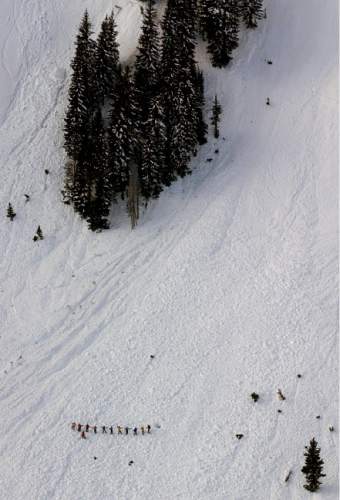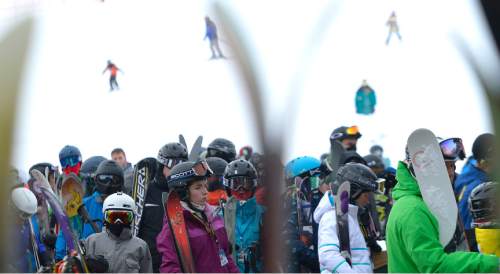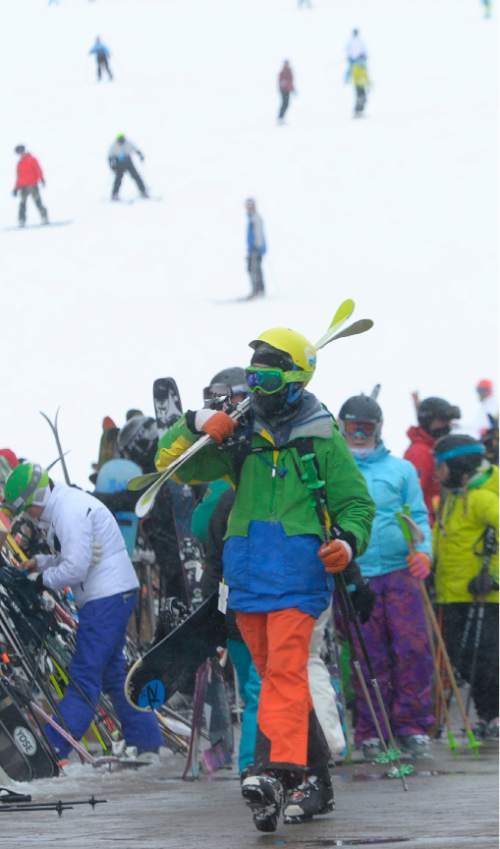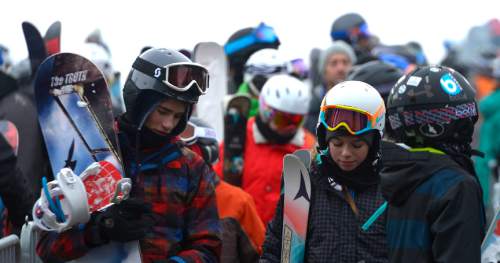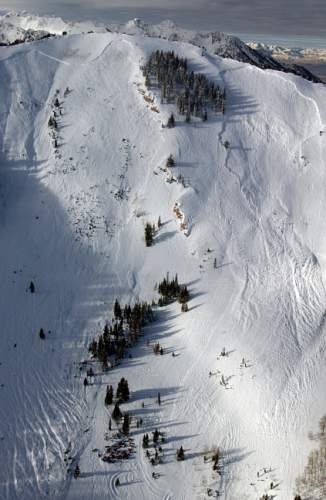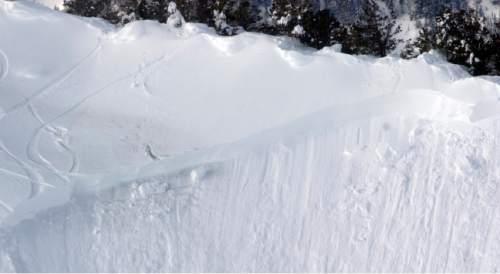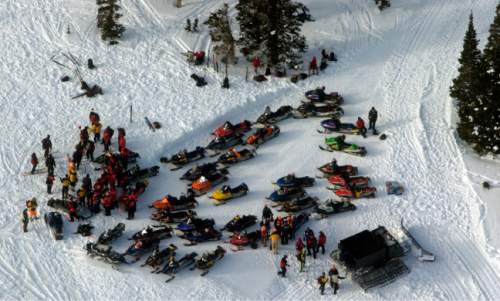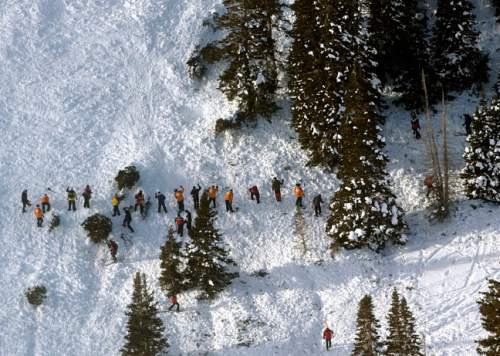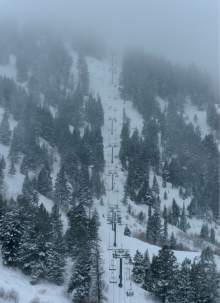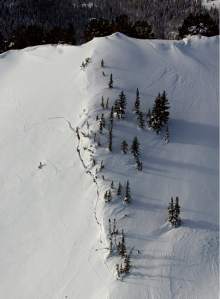This is an archived article that was published on sltrib.com in 2015, and information in the article may be outdated. It is provided only for personal research purposes and may not be reprinted.
Last March, Blake Ford took a day off from work with a friend after a storm deposited 17 inches of fresh snow at Utah's Snowbasin Resort, where the pair went to ride snowboards on what was looking like the best powder day coming at the end of very sorry season.
The boarders exited the resort through a gate at the top of the No Name area and rode the powder into Hells Canyon, which offers steep chutes but is not controlled for avalanches. Ford, 21, and his friend quickly figured the terrain was not safe and were heading back into the resort boundaries when a slide pulled out and engulfed Ford, who was in front, carving turns. The avalanche carried him 1,500 vertical feet. He was dead by the time a rescue dog located him under 3 feet of debris, according to a detailed account of the accident prepared by Snowbasin Ski Patrol staff.
Ford's fatal ride, Utah's only avalanche death for that snow-deprived winter, was a tragedy that typifies accidents in recent decades, according to a new analysis of fatal accidents by the U.S. Forest Service's Utah Avalanche Center.
The avalanche center posted the report on its blog right in front of the worst avalanche cycles to descend upon the Wasatch after a few years of low snowfall. Extreme conditions were forecast for Thursday as snow piled up by the foot Tuesday and Wednesday in the Wasatch and Uintas.
"We are advising folks to avoid the backcountry; it is particularly dangerous, and if storms keep coming, the danger will remain elevated," said Mark Staples, the center's new director, who witnessed a massive slide Thursday from the safety of the Park City ridgeline.
A skier exercising extreme caution Tuesday was hit by a slide below the eastern face of the Brighton-Park City divide. After ascending low-angled terrain through trees, she remotely triggered the slide, which carried her about 20 feet, according to a brief report posted on the avalanche center website. She came to rest with a boot protruding from the snow, and her partner extracted her unharmed.
"What more do you need to know? It doesn't get much more dangerous out there," wrote forecaster Brett Kobernik in Wednesday's forecast. "The danger will remain elevated through the weekend, and this is the type of conditions where we often see accidents."
Forecaster Drew Hardesty examined Utah's 114 fatalities dating back to 1940, covering 76 years of modern recreational winter travel in Utah avalanche terrain. He concluded that avalanche deaths have plateaued in the past decade after decades of increasing accidents that reflected the growing popularity of backcountry skiing and other winter sports, including snowboarding, snowmobiling, snowshoeing and ice climbing. Motorized-vehicle riders are now the most common avalanche casualty, accounting for 15 of the 33 deaths since 2005, according to the new report. Forecasters suspect improved education and awareness has helped many backcountry travelers avoid perilous situations.
"You can see this explosion of use in the backcountry, but fatalities are not consistent with that growth," said Hardesty, famous for his forecasts and accident reports that often wax poetic and explore the deeper meaning of winter backcountry recreation. "We would like to say we are helping things out. Our little avalanche center held together with duct tape and baling wire is making a difference."
In the past 30 years, the busiest areas for accidents have shifted from the central Wasatch, the center of Utah's ski industry, to the western Uinta Mountains and the Wasatch Plateau, which have become snowmobile havens. Snowmobiler deaths began climbing in the mid-1990s after advances in snowmobiles' traction and power enabled riders to penetrate steep bowls and cross miles of dangerous terrain in a single outing.
"While skiers and snowboarders comprise [sic] two-thirds of the fatalities since 1940, over the past 20 years alone, snowmobilers account for just over one-third of all avalanche-related deaths. Nearly one in five fatalities involve [skiers and snowboarders] going into closed or out-of-bounds terrain from one of the mountain resorts," Hardesty wrote. "Continued outreach and education to these user groups in these areas — as well as improved teaching and forecasting for persistent [slab] and deep slab avalanche problems — may well reduce the numbers of accidents and fatalities in the coming years."
And in the short term, forecasters hope skiers, boarders and other adventure-seekers will heed this week's avalanche peril and stay out of the backcountry.
"We have a persistent slab problem. We are expecting large avalanches," Staples said. "We are in situation with weak faceted snow close to the ground. It will remain a problem longer than many are willing to wait. If you go into backcountry, choose low-angle terrain."
Hardesty is even more blunt, proclaiming that the ongoing cycle of storms has "avalanche accident written all over it." The hazard is a hidden layer of granular snow, which formed on the surface during the weeks that came before last week's major storm and is now being buried under heavier loads of snow. Over time, these snow crystals become facets, which do not bind with each other and thus create a perfect sliding surface for the cohesive "slabs" of snow that accumulate on top.
"The mousetrap is set," Hardesty said. "Those facets are like a nagging cough that won't go away. They take weeks, if not months, to stabilize."
His report identified these persistent weak layers, along with deep slabs, as the avalanche conditions responsible for more than two-thirds of Utah's fatalities. The slide that killed Ford started moving on a weak layer, but it stepped all the way down to dirt and stripped the chute of nearly all its snow as it carried away Ford.
Utah's lethal avalanches are typically triggered on slopes that face north or northeast, pitched steeper than 38 degrees and exceeding 8,000 feet in elevation, according to the Hardesty report. Blake Ford's avalanche was in line with all these characteristics: He was riding a north-facing 43-degree slope at 8,700 feet above sea level when he triggered the slide, according to the accident report.
Not coincidentally, this is exactly the terrain that makes for the best skiing — the place that Hardesty says marks "that intersection of risk and desire," where backcountry travelers evaluating a slope must balance the need to avoid hidden dangers with the joys they expect to reap when they slash down an untracked run with powder blowing over their face.
"It's no accident the best runs face north. It's so cold. That's where the weak layers form, that's the habitat where faceted grains are best fostered and preserved. Most of our strong winds come from the southwest and load slopes facing northeast. It's a tragic combination of the best skiing and most unstable snow," Hardesty said.
Ford's death speaks to another troubling trend. Several fatalities resulted from resort skiers who leave the safety of controlled terrain to hunt for powder stashes just beyond the boundary ropes.
"The cost of admission is so low; you just walk out the gate. The snow looks exactly the same, but as we know, it's not. It's completely different," Staples said.
Hardesty wonders if resorts' success controlling for avalanches has lured their customers into a false sense of security.
"The ski patrolmen do almost too good of a job. There have been few in-bounds fatalities. Those guys and gals do a knockout job sticking their necks out to make it safe," he said. In the last 20 years, only one resort skier died in an in-bounds slide, while 13 have died in the "sidecountry." This toll includes snowboarders Allen Chatwin and Richard Jones, both 18, killed in 2002 outside Brighton Ski Resort after venturing through a gate onto the north face of Pioneer Ridge above Dog Lake. Jones had been to the area, easily accessed from the top of the Crest lift, many times before, but no one in his large party carried beacons or rescue gear aside from shovels to build kickers.
Utah's avalanche deaths peaked in the winter of 2004-05 with eight. In the decade since, Utah has average 3.3 deaths per winter, down from four in the preceding decade.
Nationally, 11 died last year, well-below the 35 to 40 killed by avalanches most years.
Staples cautioned against drawing firm conclusions from Utah's avalanche data, which offer such a small sample size. Recent declines in fatalities may simply reflect lower numbers of people visiting the backcountry during the past three winters of poor snowfall. That trend could suddenly reverse if Mother Nature serves up generous helpings of Utah's famous powder, he said, particularly if they come just in time for the holiday rush.
"There's a lot we don't know. A decision that one party makes that leads to a fatality can really skew the numbers. It's safe to assume there were less people going out" during the low-snow winters, he said. "We didn't have big storms like this that deliver tons of powder that gets people pumped up."
Staples said Tuesday's slide that caught a Snowbasin ski patroller highlights the risks snow-safety workers face as they deploy explosives to release unstable slopes before the public is invited to ski them. The 15-year veteran patroller escaped only with possible rib fractures, but this ride is a sign of how hazardous conditions are this week.
"These are the pros. If they are being surprised, that should be a heads-up for the rest of us," Staples said.
Brian Maffly covers public lands for The Salt Lake Tribune. Maffly can be reached at bmaffly@sltrib.com or 801-257-8713. Twitter: @brianmaffly


